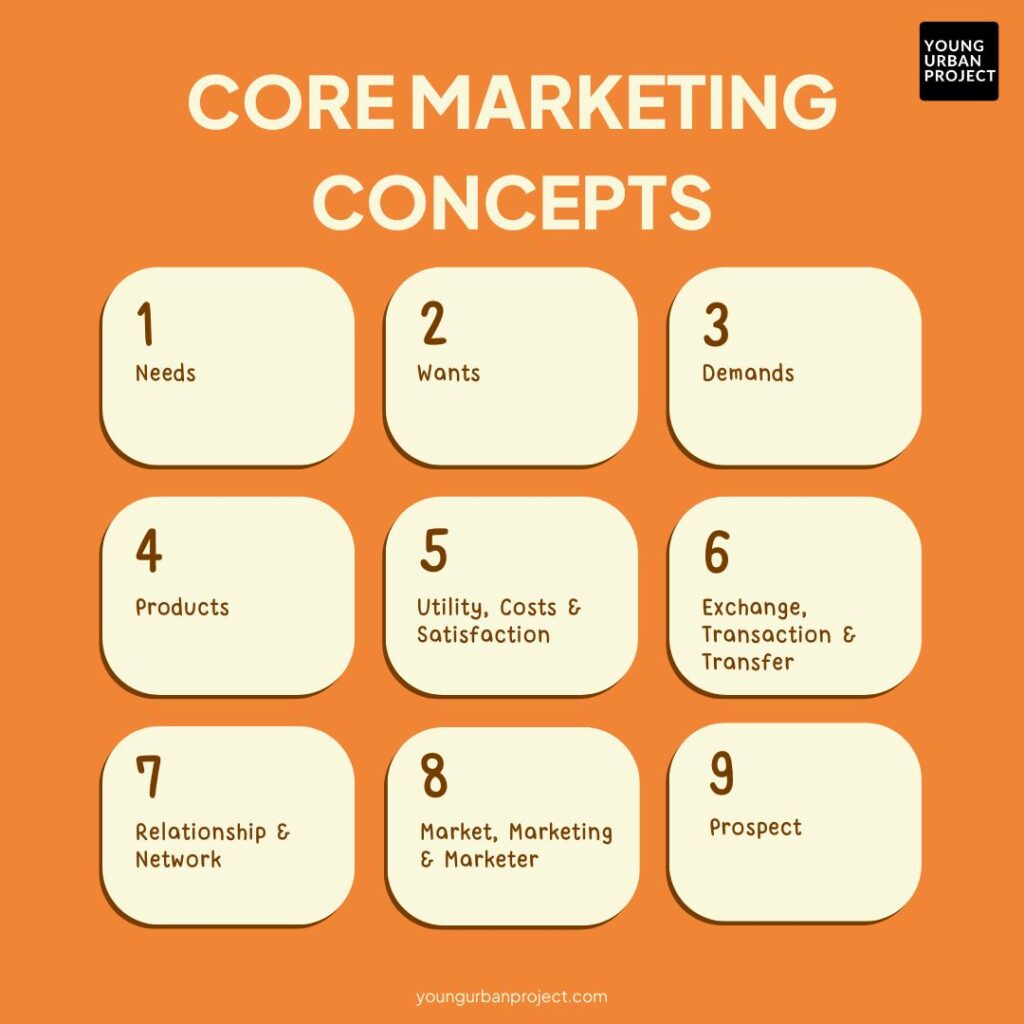What makes some products fly off the shelves while others struggle to gain attention? The secret lies in mastering the core concepts of marketing. These fundamental principles guide how companies identify customer needs, create value, and build lasting relationships with their target audience. Whether you’re running a small business or working on a big marketing campaign, getting these basics right is key to success.
Table of Contents
In this blog, we’ll walk through the essential ideas behind marketing. We’ll talk about the difference between what people need and want, how to create products that customers love, and why building strong relationships with your audience matters. By the end, you’ll have a clear picture of how to use marketing concepts in your own marketing efforts, whether you’re focusing on traditional methods or diving into digital marketing. Let’s get started!
What is Marketing?
Marketing is how businesses connect with people who need their products or services. It’s not just about selling—it’s about understanding customer needs and offering the right solutions.
It starts with identifying a problem or desire. Businesses then create products, services, or experiences to fulfill those needs. Marketing helps communicate these solutions to the right audience through advertising, promotions, social media, and more. It also includes pricing, packaging, and product placement to attract and retain customers.
Marketing happens both online and offline. Digital marketing uses websites, emails, and social media, while traditional marketing includes TV ads, billboards, and print media.
In short, marketing is the art of making people say, “I need that!” And when done right, it doesn’t just drive sales—it builds trust, loyalty, and a lasting connection with your target market.
Also read: Scope of Marketing: Nature, Importance and Career Opportunities
Core Marketing Concepts

1. Needs
Needs are basic human requirements. They include things like food, water, shelter, and safety. These are essential for survival. Without needs, life would be difficult. Needs are not created by marketers. They exist naturally. Marketers identify these needs. They then try to offer solutions. Needs are universal. Everyone has them. They are the starting point for all marketing activities.
For example: A person needs food, water, and shelter to live. Without these, survival is hard. Businesses study basic needs to create products, like bottled water or energy bars, that fulfill them.
2. Wants
Wants are desires for specific things. They are shaped by culture and personality. To give an example, one person may want a burger, another a salad. Wants go beyond basic needs. They are not necessary for survival. Marketers influence wants. They create products that appeal to these desires. Wants can change over time. They vary from person to person. Wants drive consumer choices.
For example: A person needs food but may want a pizza. Wants depend on culture, trends, and lifestyle. Companies create products that match people’s wants, like different pizza flavors or diet-friendly options.
3. Demands
Demands are wants backed by buying power. People may want many things. But they only demand what they can afford. Like, someone may want a luxury car. But they demand a budget car. Demands depend on income and resources. Marketers focus on turning wants into demands. They offer affordable options. Demands reflect what people are willing to pay for.
For example: A person may want a luxury car, but only those who can afford it create demand. Demand exists when a want is backed by the ability and willingness to pay.

Enroll Now: Advanced Digital Marketing Course
4. Products
Products are items that satisfy needs or wants. They can be physical goods, services, or ideas. To give an example, a phone is a product. So is a haircut. Products solve problems. They make life easier or better. Marketers create and promote products. They ensure products meet customer needs. Products must offer value. They should be better than competitors. Products are the core of marketing.
For example: A smartphone is a product designed to meet communication and entertainment needs. It has features like cameras, apps, and internet access, making it valuable for both work and personal use.
5. Utility, Costs & Satisfaction
Utility is the value a product offers. It includes form, time, place, and ownership. Costs are what customers give up to get the product. Satisfaction is how happy customers are with the product. Marketers aim to maximize utility. They try to reduce costs. High satisfaction leads to repeat purchases. Balancing these three is key to success.
For example: A customer buys a coffee for convenience and taste (utility). The price is the cost. If the coffee meets expectations, the customer feels satisfied and may buy again in the future.
6. Exchange, Transaction & Transfer
Exchange is getting something by offering something else. Like, money for a product. A transaction is a completed exchange. It involves a deal between two parties. Transfer is giving something without expecting anything in return. Marketing focuses on exchanges and transactions. These are the basis of business. Transfers are less common in marketing.
For example: A customer gives money to buy a book (exchange). The bookstore gives the book in return (transaction). If the book is gifted later, ownership changes without payment (transfer).
7. Relationship & Network
Relationship marketing builds strong connections with customers. It focuses on long-term satisfaction. Networks are groups of people or businesses connected for mutual benefit. Good relationships lead to loyalty. Networks help in reaching more customers. Both are important for growth. They create trust and repeat business. Marketers invest in both to succeed.
For example: A business builds relationships by offering discounts to loyal customers. A network forms when satisfied customers recommend the brand to friends, creating trust and expanding the company’s reach.
8. Market, Marketing & Marketer
A market refers to a location, either physical or digital, where buyers and sellers interact. Marketing involves promoting and selling goods or services. A marketer is someone who does this work. They identify customer needs. They create strategies to meet those needs. Markets are competitive so marketing must be effective. Therefore marketers must understand their audience.
For example: The market includes all buyers and sellers of smartphones. Marketing involves promoting phones through ads. A marketer studies customer needs and creates campaigns to attract buyers and boost sales.
Enroll Now: Performance Marketing Training
9. Prospect
A prospect is a potential customer. They show interest in a product, but they haven’t bought it yet. Marketers identify prospects. They try to convert them into buyers. Prospects are valuable. They represent future sales. Marketers use various tools to attract prospects. These include ads, emails, and social media. Converting prospects is a key goal in marketing.
For example: A person interested in buying a gym membership is a prospect. If convinced, they become a customer. Businesses target prospects with offers, like free trials, to turn them into buyers.
Conclusion
Marketing is more than just promoting a product or service—it’s about understanding people, their needs, and how to provide value. The core concept of marketing helps businesses build strong relationships with customers and create effective marketing strategies. By recognizing the difference between needs, wants, and demands, businesses can offer the right solutions. Understanding exchange, transactions, and networks helps in building customer trust. A good marketer knows how to position a product, communicate its value, and keep customers engaged.
In today’s digital world, marketing is constantly evolving. Businesses must adapt to new trends, technologies, and customer behaviors to stay ahead. Whether through traditional methods or digital marketing, applying these core marketing concepts is key to success. Mastering marketing basics gives you a strong foundation to grow a brand, attract the right audience, and build lasting connections. When done right, marketing is not just about selling—it’s about creating value and trust.
FAQs: Core Concepts of Marketing
1. What are the core concepts of marketing?
The core concepts of marketing include needs, wants, and demands; products and services; utility, costs, and satisfaction; exchange, transactions, and transfer; relationships and networks; markets, marketing, and marketers; and prospects. These marketing concepts help businesses understand customer behavior and create effective marketing strategies.
2. Why is understanding customer needs important in marketing?
Understanding customer needs helps businesses create products or services that solve real problems. When a company knows what customers want, it can offer better solutions, improve customer satisfaction, and build long-term relationships.
3. How do “needs,” “wants,” and “demands” differ in marketing?
Needs are basic human requirements essential for survival (e.g., food, water). Wants are desires shaped by culture and personal preferences (e.g., pizza, smartphone). Demands are wants backed by purchasing power—people desire something and can afford it. Marketers aim to fulfill needs, influence wants, and create demand by offering products consumers can afford and desire.
4. What is the role of exchange in marketing?
Exchange is the process where a customer gives something valuable (like money) in return for a product or service. It’s a key part of marketing that ensures businesses provide solutions customers are willing to pay for.
5. How does digital marketing fit into core marketing concepts?
Digital marketing uses online platforms like social media, search engines, and email to apply core marketing concepts. It helps businesses connect with their target audience, understand their needs, and create personalized marketing strategies.
6. Why is relationship marketing important?
Relationship marketing focuses on building strong, long-term customer relationships rather than just making one-time sales. It increases customer loyalty, improves brand reputation, and boosts repeat business.

